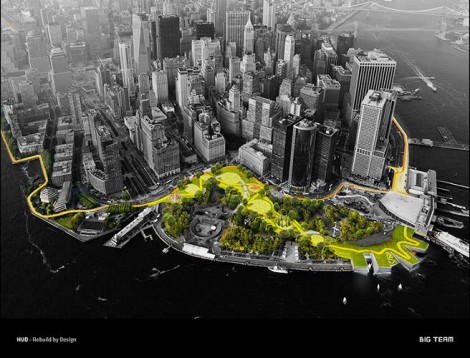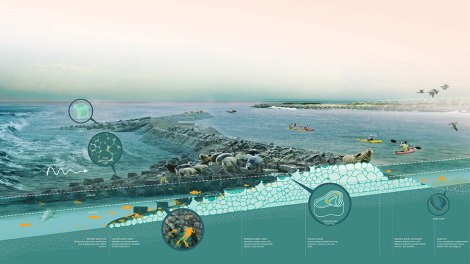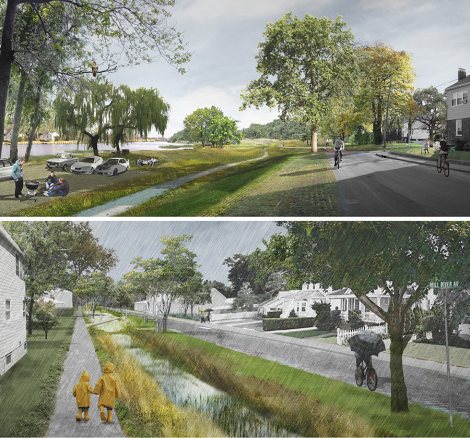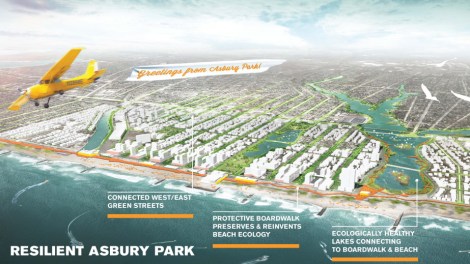Uh-oh. Take note, New Yorkers, Hurricane Sandy wasn’t just a one-time thing. According to a new study, New York City’s seawall could be overrun by storm surges every four to five years. And today’s storms are not your grandfather’s storms: Thanks to climate change, they will become more frequent, more severe, and cause more damage than Sandy did.
New York City’s current seawall is barely six feet tall. After Sandy hit, there was talk of building a new one, but not much has happened yet. But with climate change happening soon now, big cities like New York better find a way to adapt their aging infrastructure and update their flood management plans, stat.
Enter Rebuild by Design, a competition challenging teams to find innovative solutions to rising storm surges and sea levels around New York. The competition is sponsored by the Hurricane Sandy Rebuilding Task Force, and guided by the U.S. Department of Housing and Urban Development (HUD). Last month, 10 projects were selected as finalists, and the proposals are ambitious – from building a chain of barrier islands stretching across the Eastern seaboard, to giving the Jersey Shore a complete eco-makeover.
HUD Secretary Shaun Donovan says that it’s not about simply rebuilding what existed before, but “changing a culture” to think about resiliency in the face of future storms. The winners of Rebuild by Design stand to see their visions turned into reality, since HUD plans to fund some of the projects with disaster-recovery grants and a combination of public and private funding. Here are our top picks from among the finalists, along with their “feasibility factors” — that is, our read on whether these projects will sink or float.
1. “Oyster-tecture”
The Living Breakwaters project combines “risk reduction with ecological regeneration.” Taking a lesson from Hurricane Katrina (that levees can break, and catastrophically), the project instead proposes a variety of approaches for Raritan Bay in Staten Island and New Jersey, including stepped dunes, tidal flats, and offshore breakwaters (rocky, sloped walls that dissipate wave energy).
But the coolest part of this project is the proposal to line some of the reef areas with oysters, which provide a natural, soft barrier against waves. SCAPE studios has used oysters as urban change agents before with a small pilot project in 2010 where they lowered baby oyster orphans on fuzzy ropes (so cute!) into the Gowanus Canal superfund site. This time they’re working with the Billion Oyster Project to create “Reef Street” – “micro-pockets” of living reefs filled with finfish, shellfish, and lobsters along the bay.
Feasibility Factor: MEDIUM. Soft barriers like reefs are great for gradual rising sea levels but not so great for protection from superstorms. And the project could face one pretty significant hurdle: Turns out New Jersey’s Department of Environmental Protection doesn’t approve of oyster reefs. Why? Because people will take them and eat them (probably deep fried, see No. 5)!
2. Make some islands
Barrier islands like Coney island, Long Beach, and the Rockaways got hit hard during Sandy. The Blue Dunes project aims to build a resilient coastline with a chain of barrier island dunes that stretches from Cape Cod in Massachusetts to Cape May in New Jersey, all along the Eastern Seaboard. The dunes would act as a buffer from storms like Sandy and offer a natural alternative to a giant seawall, as well as introducing new habitats for wildlife.
Feasibility Factor: LOW. Such a large-scale intervention would require getting other states like Massachusetts and Connecticut on board with the idea. It would also probably be massively expensive as well.
3. Put a park on it

The Big U
The Big U project imagines a 10-mile loop of parkland hugging the lower half of Manhattan that would protect low-lying neighborhoods from flooding. Trying to move away from the Robert Moses, efficiency first, people last kind of mentality, Big U focuses on civic infrastructure and “hedonistic sustainability.” The park will feature elevated bike lanes, footpaths, and vertical farms. Art-bedecked “deployable walls” underneath the FDR Highway would flip down when it floods and flip back up when it’s dry. A “reverse aquarium” that’s also a flood barrier would jut out into the water to let people see tide levels for themselves.
Feasibility Factor: HIGH. Since each aspect of the project is designed to stand on its own, this could be funded piece by piece. And after the success of the elevated High Line park, this may be a project that everyone could get behind.
4. Go Dutch
The Dutch are experts at living with the water. In fact, one of the competition’s judges is Henk Ovink, a water-planning wunderkind from the Netherlands, whom Obama asked to help rethink New York City’s approach to flood infrastructure in the face of climate change. The Interboro team believes there is no “single bullet solution” to flood management, so it has developed a comprehensive solution to protecting Long Island’s south shore that takes a page out of the Dutch’s water survival book.
The plan includes working with nature to build a “smart system” of dikes, dams, and levees that would make the north-south waterways on Long Island that flood during storms into ‘blue-green corridors’ that store water. They also want to help low-income neighborhoods develop “housing options in high and dry areas near public transportation” and work to form local, grassroots water boards — regional planning groups that work together to solve water management issues.
Feasibility Factor: MEDIUM. For this plan to be successful, the tri-state area would have to work together and cooperate. That means New York City not only acknowledging New Jersey and Connecticut’s existence, but also playing nice (no jokes about how bad New Jersey smells!). Additionally, the idea of regional, cooperative water boards hasn’t gone over too well with New York and New Jersey so far. Because (gasp) socialism.
5. Jersey Shore makeover
Hey, Jersey Shore! Time to lose the hairspray and the nail decals, the muscle shirts, the endless burger/hot dog/pizza/deep-fried everything stands, and that ratty wooden boardwalk with roller coasters that do this during storms. The shore suffers not just from storm damage and sea-level rise, but also from tourism, which has adversely affected the ecology of this area. Sasaki Associates want to bring the delicate and diverse ecological balance back to the Jersey Shore, which consists of barrier islands, headlands, and the inland bay.
Using Asbury Park as their case study, Sasaki Associates say the current boardwalk exists with “hard edges, not healthy ecosystems.” The proposed project Resilience + The Beach envisions a new hybrid dune-boardwalk system that would capture sand to help form dune barriers. The team also plans to remake the Jersey Shore into an eco-tourism hub where, instead of sun-tanning and jet skiing, people can kayak and bird watch.
Feasibility Factor: LOW. The hitch with this plan is that in order to restore some of these ecosystems, some people are going to have to get the hell out — the polite term is actually “managed retreat.” Administrations tend to view managed retreat as their last option, since they associate it with giving up. And, asking people to give up their beachfront properties even in the face of more storms will be difficult, if not impossible.
The conversation would probably go something like this:
[protected-iframe id=”bc6997c3992f7f82077200dcb59b70e4-5104299-61069804″ info=”https://giphy.com/embed/4OaZWXGxrpekE” width=”450″ height=”282″ frameborder=”0″ webkitallowfullscreen=”” mozallowfullscreen=”” allowfullscreen=””]
[protected-iframe id=”804db0455c84c170aeb9740d3fa9445b-5104299-61069804″ info=”https://giphy.com/embed/133TiCFvyZBKHS” width=”450″ height=”278″ frameborder=”0″ webkitallowfullscreen=”” mozallowfullscreen=”” allowfullscreen=””]






